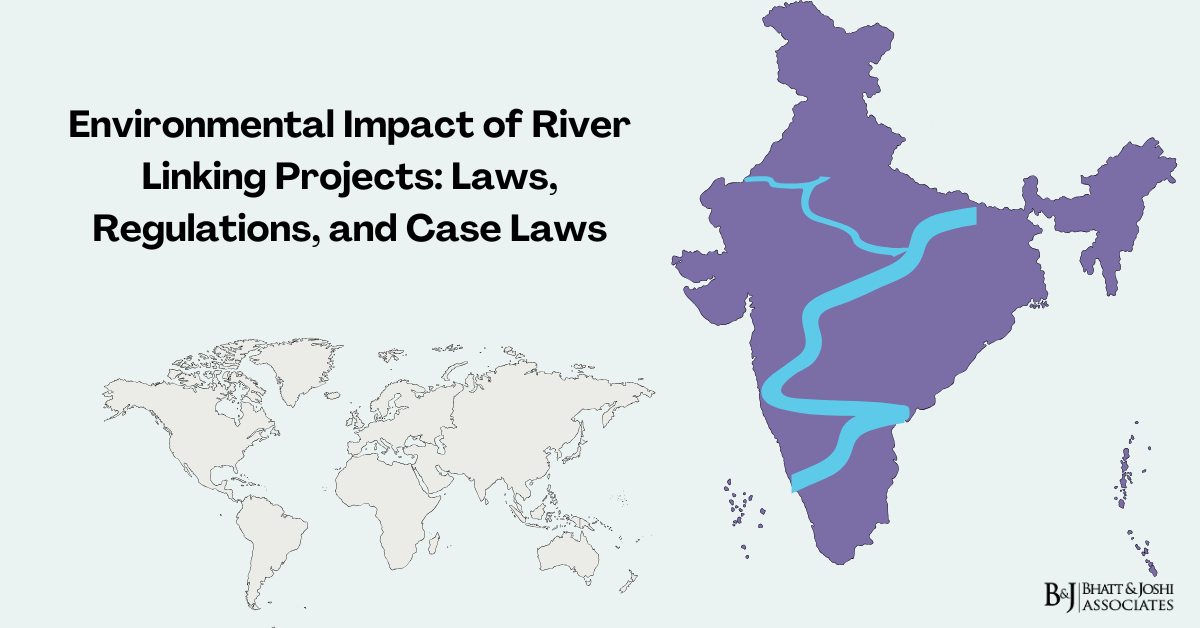Introduction
River linking projects have been presented as a solution to India’s pressing water crises. The uneven distribution of water resources across the country, where some regions face droughts and others face floods, has fueled the idea of redistributing water by linking rivers through canals and reservoirs. The National Perspective Plan (NPP) formulated by the Ministry of Water Resources envisages 30 river linking projects, aiming to transfer water from surplus basins to water-scarce areas. These projects promise several benefits, such as improved irrigation, better flood control, and ensuring water availability in arid regions. However, such large-scale interventions have significant environmental, social, and ecological consequences. The environmental impact of river linking projects is profound, influencing ecosystems, biodiversity, water quality, and even climate patterns. These projects also affect local populations and traditional livelihoods, particularly in regions dependent on natural river systems. Despite the touted benefits of river linking, the long-term environmental costs must be carefully considered and weighed against the potential advantages. In this expanded article, we will delve deeper into the environmental impacts of river linking projects, the regulatory frameworks that govern these interventions, case laws that have addressed the related environmental issues, and the future outlook for balancing development with environmental sustainability.
The Concept of River Linking and Its Environmental Implications
The interlinking of rivers (ILR) involves diverting water from rivers with excess flow to rivers experiencing deficits. This is generally achieved through a network of dams, canals, tunnels, and reservoirs that allow for the redistribution of water. The idea behind ILR is to maximize the utilization of available water resources, mitigate water scarcity, and ensure more equitable water distribution. While the benefits of ILR, such as increasing irrigation potential, enhancing water supply for domestic and industrial use, and flood management, are often emphasized, the environmental impacts are far-reaching and multifaceted.
One of the major environmental concerns associated with river linking is the alteration of natural ecosystems. Rivers play a crucial role in maintaining the ecological balance of their surrounding environments. Any diversion or modification of river flow can result in the destruction of aquatic habitats, loss of biodiversity, and disruption of the natural hydrological cycle. The construction of large dams and reservoirs for river linking projects can lead to the submergence of vast tracts of forested land, displacing wildlife and local populations. The change in water flow dynamics may also lead to the degradation of downstream ecosystems, affecting the flora and fauna that depend on these water bodies for survival.
In addition, river linking can have significant impacts on water quality. By altering the natural course of rivers, the composition of the water, sediment load, and nutrient balance may be disrupted. This can result in changes to the chemical makeup of the water, with consequences for both human health and the environment. For example, increased sedimentation in linked rivers may reduce the water’s capacity to support aquatic life, leading to the decline of fish populations and other aquatic species. Similarly, the alteration of flow patterns can exacerbate issues such as salinization in coastal rivers and wetlands, negatively affecting agriculture and local communities.
Beyond these ecological concerns, river linking projects also have socio-economic implications. The displacement of local populations, particularly indigenous and tribal communities, is a major issue. Many of these communities rely on rivers for their livelihoods, engaging in activities such as fishing, agriculture, and gathering forest products. The construction of dams and reservoirs often leads to the displacement of these communities, disrupting their traditional way of life and leading to loss of income. Additionally, the redistribution of water between regions can lead to conflicts between states and local communities over water rights and access to resources, as seen in disputes over river basins like the Cauvery, Krishna, and Godavari.
Regulatory Framework Governing River Linking Projects
In light of the socio-economic and environmental impact of river linking projects, several laws and regulations have been enacted to ensure that these projects are carried out in an environmentally sustainable and socially responsible manner. The regulatory framework governing river linking projects in India is extensive, covering various aspects of environmental protection, forest conservation, wildlife protection, and water management.
The Environment (Protection) Act, 1986: This is the primary legislation for environmental protection in India. The Act gives the central government the authority to regulate and control pollution, manage environmental issues, and ensure sustainable development. River linking projects are required to undergo a thorough Environmental Impact Assessment (EIA) under the provisions of this Act. The EIA process involves evaluating the potential environmental effects of the project, including impacts on air, water, soil, flora, and fauna. Based on the findings, the project must incorporate mitigation measures to minimize the negative environmental impacts. Public consultations are also an important part of the EIA process, allowing affected communities to express their concerns.
The Forest (Conservation) Act, 1980: This Act regulates the diversion of forest land for non-forest purposes, which is often required for river linking projects involving the construction of dams, canals, and reservoirs. Under the Act, prior approval from the central government is mandatory before any forest land can be diverted for a project. River linking projects often result in the destruction of large tracts of forested areas, leading to loss of biodiversity and disruption of ecosystems. The clearance process requires the project proponents to provide compensatory afforestation, which involves planting trees in other areas to offset the loss of forest cover. However, this practice has been criticized for failing to replicate the ecological value of old-growth forests.
The Wildlife (Protection) Act, 1972: This Act provides for the protection of wildlife and their habitats. River linking projects often pass through ecologically sensitive areas, including wildlife sanctuaries, national parks, and tiger reserves. For instance, the Ken-Betwa river linking project, which proposes to link the Ken and Betwa rivers, threatens to submerge parts of the Panna Tiger Reserve in Madhya Pradesh, which is home to a significant population of tigers and other endangered species. Under this Act, projects that affect protected areas must be approved by the National Board for Wildlife, which assesses the potential impact on wildlife and their habitats. The Act also mandates the creation of mitigation plans to minimize harm to wildlife, including the construction of wildlife corridors and the relocation of affected species.
The Water (Prevention and Control of Pollution) Act, 1974: This Act focuses on preventing and controlling water pollution in India. River linking projects can lead to increased pollution due to changes in water flow patterns, sedimentation, and the introduction of pollutants from agricultural runoff. The Act establishes Central and State Pollution Control Boards, which are responsible for monitoring water quality and ensuring that river linking projects comply with pollution control norms. The Act also mandates that water quality be maintained at standards suitable for agriculture, industry, and drinking purposes, and that effluents from river linking projects do not exceed permissible limits.
The National Green Tribunal (NGT) Act, 2010: The National Green Tribunal (NGT) is a specialized judicial body established to handle environmental disputes and ensure compliance with environmental laws. The NGT has played a crucial role in regulating river linking projects by ensuring that they undergo rigorous environmental assessments and adhere to legal requirements. The NGT can issue orders to halt or modify projects that are found to cause environmental harm. It has actively intervened in cases such as the Polavaram Project, where environmental clearance procedures were scrutinized. By providing a legal platform for environmental protection, the NGT helps safeguard against the ecological degradation caused by large-scale infrastructure projects like river linking.
Case Laws on Environmental Impact of River Linking Projects
Indian courts have been instrumental in shaping the discourse around river linking projects, particularly regarding their environmental and social impacts. Several key judgments have addressed the balance between development and environmental conservation, emphasizing the need for sustainable development. These judgments have set important precedents for future river linking projects.
Narmada Bachao Andolan v. Union of India (2000): This landmark case dealt with the construction of the Sardar Sarovar Dam on the Narmada River. Although not directly related to river linking, the case raised significant environmental and social concerns that are applicable to river linking projects. The Supreme Court ruled that development projects must not proceed at the cost of the environment and human rights. The Court emphasized the need for proper environmental assessments, rehabilitation measures for displaced persons, and a balance between development and environmental conservation. The judgment reinforced the principle of sustainable development and highlighted the importance of environmental protection in large-scale water management projects.
M.C. Mehta v. Union of India (1997): This case focused on pollution in the Ganga River but is relevant to river linking projects because of its emphasis on water conservation and pollution control. The Supreme Court ruled that the government must take immediate steps to prevent pollution and protect water bodies from degradation. The Court’s emphasis on sustainable development and the responsibility of the state to protect natural resources has important implications for river linking projects, particularly those that affect water quality and river ecosystems. The case underscored the need for stringent pollution control measures and the preservation of water resources for future generations.
Ken-Betwa River Linking Project Case: One of the most controversial river linking projects in India is the Ken-Betwa link, which seeks to transfer water from the Ken River to the Betwa River. The project has faced legal challenges due to its environmental impact on the Panna Tiger Reserve, a critical habitat for tigers and other endangered species. Environmentalists have argued that the project will lead to the submergence of large areas of forest and the displacement of wildlife. The National Green Tribunal has been actively involved in overseeing the environmental clearances for the project and ensuring compliance with environmental norms. The case highlights the importance of protecting wildlife and their habitats in the face of development pressures.
Tehri Dam Case (Tehri Bandh Virodhi Sangarsh Samiti v. State of U.P., 1990): The Tehri Dam case is relevant to river linking projects as it deals with the environmental implications of large water management projects. The Supreme Court acknowledged the environmental risks associated with the Tehri Dam, including the displacement of people, the submergence of forests, and the disruption of ecosystems. However, the Court also recognized the importance of such projects for the country’s economic development. The judgment highlights the judiciary’s attempt to strike a balance between environmental conservation and developmental needs. This approach is often applied in river linking cases, where the potential benefits of water redistribution must be weighed against environmental costs.
Polavaram Project Case: The Polavaram Project involves inter-basin water transfer and has raised environmental concerns similar to those faced by river linking projects. The National Green Tribunal has played an active role in overseeing the environmental clearance process for the project. The Tribunal directed the project authorities to ensure compliance with environmental regulations, including the preparation of a detailed EIA and the implementation of mitigation measures. The NGT’s intervention in the Polavaram Project reflects the growing judicial oversight over large-scale water management projects and the need to prioritize environmental sustainability.
Judicial Oversight and the Role of the National Green Tribunal
The National Green Tribunal (NGT) has emerged as a key institution in regulating river linking projects and ensuring that environmental laws are followed. The NGT’s role is to adjudicate environmental disputes, review the environmental impact assessments of large infrastructure projects, and ensure compliance with environmental regulations. The Tribunal has been instrumental in scrutinizing river linking projects and holding developers accountable for any violations of environmental norms.
In the case of the Polavaram Project, for example, the NGT directed the project authorities to ensure that environmental clearance procedures were strictly followed. The Tribunal also emphasized the need for public consultations and transparency in the decision-making process. Through its rulings, the NGT has helped ensure that river linking projects are carried out in a manner that minimizes environmental harm and takes into account the concerns of affected communities.
Environmental Impact Assessments and the Precautionary Principle
Environmental Impact Assessments (EIA) are a critical regulatory tool for assessing the environmental impacts of river linking projects. Under the EIA Notification of 2006, all major infrastructure projects, including river linking, must undergo a detailed EIA before they can proceed. The EIA process involves identifying potential environmental risks, evaluating the significance of these risks, and proposing mitigation measures to minimize harm.
The precautionary principle is an important concept in environmental law that requires preventive action to be taken to avoid environmental harm, even in the absence of scientific certainty. This principle has been endorsed by the Supreme Court in several landmark cases, including Vellore Citizens Welfare Forum v. Union of India (1996). The precautionary principle is particularly relevant to river linking projects, as the long-term environmental impacts of such projects are often uncertain. By applying this principle, project developers are required to take preventive measures to minimize environmental damage, even if the full extent of the harm is not yet known.
Challenges and the Way Forward
Despite the potential benefits of river linking projects, they present significant environmental and social challenges. One of the primary concerns is the alteration of natural river ecosystems, which can lead to the loss of biodiversity, the disruption of aquatic habitats, and the destruction of wetlands. The displacement of human populations, particularly indigenous communities, is another major issue that needs to be addressed. Furthermore, the redistribution of water between regions can lead to conflicts over water rights, as seen in the long-standing disputes over rivers like the Cauvery, Krishna, and Godavari.
To mitigate the social and environmental impact of river linking projects, it is essential to adopt a holistic approach that considers the ecological, social, and economic dimensions of water management. Strengthening the regulatory framework, ensuring strict compliance with environmental laws, and promoting public participation in decision-making processes are crucial steps toward sustainable water management. Additionally, innovative approaches to water conservation, such as rainwater harvesting and watershed management, should be explored as alternatives to large-scale river linking projects.
Conclusion
River linking projects, while promising in terms of addressing water scarcity and flood management, pose significant environmental risks. The regulatory framework governing these projects, including the Environment (Protection) Act, 1986, the Forest (Conservation) Act, 1980, and the Wildlife (Protection) Act, 1972, provides a robust mechanism for safeguarding the environment. Judicial oversight, particularly through the National Green Tribunal, plays a crucial role in ensuring that environmental concerns are not overlooked in the pursuit of development. By integrating environmental sustainability into the planning and execution of river linking projects, India can strike a balance between the need for water resource management and the imperative of protecting its natural ecosystems for future generations.














